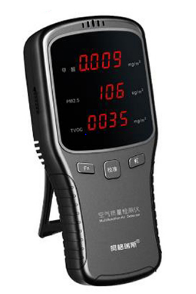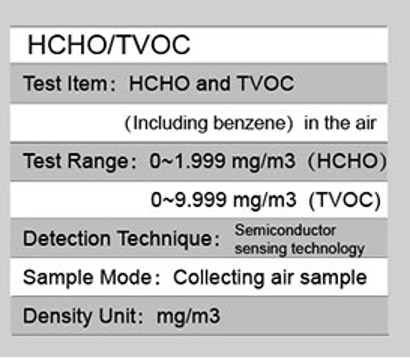By Dr Raffaele Conte
INTRODUCTION
Volatile organic compounds (VOCs) are substances with high vapour pressure and low water solubility. Many VOCs are human-made chemicals produced in the manufacture and utilization of paints, pharmaceuticals, and refrigerants. Examples of VOCs are industrial solvents, such as trichloroethylene, methyl ethyl ketone, methyl isobutyl ketone; fuel oxygenates, such as methyl tert-butyl ether (MTBE); by-products produced by chlorination in water treatment, such as chloroform; and derivates of petroleum fuels, such as benzene. [1]
Volatile organic compounds (VOCs) are emitted in the form of gases from certain solids or liquids. Their concentrations are consistently higher indoors than outdoors due to the widespread distribution of products that emit VOCs such as paints and lacquers, paint strippers, cleaning supplies, pesticides, building materials and furnishings, office equipment such as copiers and printers, correction fluids and carbonless copy paper, graphics and craft materials including glues and adhesives, permanent markers, photographic solutions, cleaning, disinfecting, cosmetic, degreasing, and hobby products. [2]
In particular, studies of EPA’s Total Exposure Assessment Methodology (TEAM) [3] found levels of common organic pollutants to be 2 to 5 times higher inside homes than outside, regardless of whether the homes are located in rural or highly industrial areas. Additional TEAM studies indicate that while people are using products containing organic chemicals, they can expose themselves and others to very high pollutant levels, and elevated concentrations can persist in the air long after the activity is completed. For example, some activities (smoking, visiting dry cleaners or service stations) and occupations (chemical, paint, and plastics plants) are associated with significantly elevated exposures and breath levels for certain toxic chemicals, and homes with smokers have significantly increased benzene and styrene levels in indoor air. [3]
VOCs are known to have short- and long-term adverse health effects. These may include eye, nose and throat irritation, headaches, loss of coordination and nausea, damage to liver, kidney and central nervous system, and cancer. Early symptoms indicative of VOCs intoxication are conjunctival irritation, nose and throat discomfort, headache, allergic skin reaction, dyspnea, decline in serum cholinesterase levels, nausea, emesis, epistaxis, fatigue, and dizziness. [4]
However, the danger of VOCs varies greatly due to the simultaneous presence of highly toxic chemicals and VOCs with no known health effect. Moreover, the extent and nature of the health effect depends on level of exposure and length of time exposed. [4]
MEASUREMENT WITH AIR QUALITY DETECTORS
Low-cost air quality detectors are attracting more attention in the scientific community due to their ability to offer air pollution monitoring at a lower cost than conventional methods, making air pollution monitoring possible in many more locations. (fig. 1)

Figure 1. Low-cost air quality detectors
There are several categories of detectors with different sensors available. Electrochemical sensors are based on a chemical reaction between gases in the air and the electrode in a liquid inside the sensor. Metal oxide sensors (resistive sensor, semiconductor) work through the gases in the air that react on the sensors surface modifying their resistance. The photo ionization detector ionises volatile organic compounds and measures the resulting electrical current. Optical sensors detect gases like carbon monoxide and carbon dioxide by measuring the absorption of infrared light [5] [6]. In this work a metal oxide sensor was used which was able to guarantee good sensitivity, from mg/m3 to µg/m3, and fast response time (30-200s). On the other hand, this type of sensor is highly sensible to temperature and humidity variations and can show cross-reactivity with similar molecule types. In particular, the measurements were made using a WP6910T indoor PM2.5 and TVOC/ HCHO air quality monitor detector meter analyzer by VSON (Vson Technology Co., Ltd., Bao’an area of Shenzhen City, China). The working principle is based on semiconductor sensing technology (fig.2 ) and such a sensor is able to detect also formaldehyde and benzene in the air. [7] (fig 2)

Figure 2. Characteristics of WP6910T indoor PM2.5 and TVOC/ HCHO air quality monitor detector
EXPERIMENTAL
The utilization of air quality monitor detectors to measure the release of VOCs from solids or liquids requires the setting of reproducible and controlled conditions. The developed protocol proposes the utilization of a hermetically sealed chamber placed in an environment where it is possible to control external conditions. In particular, the unknown solid (recommended weight 5 grams) or liquid (recommended volume 5 ml) must be placed in a open volumetric flask inside an hermetically sealed chamber with a volume of 5 liters at a controlled temperature of 25°C and pressure of 1 atm.
VOC concentration at saturation must be measured after 60 minutes of evaporation from the volumetric flask; the kinetics can be obtained by measuring the release after 1,2,3,10, 30 minutes.
To obtain a reproducible measure of VOCs, the sealed chamber must be opened inside a hood, with forced aspiration, and the detector must be placed on the top of the flask containing the unknown liquid or solid.
The accurate application of this procedure results in a reliable quantitative measure.
As example, Table 1 shows kinetic data obtained for the measurement of a unknown fluid (proven to be a concentrated room fragrance) analyzed during the author’s activity as forensic toxicologist.

Table 1. Kinetic data of VOCs and formaldehyde release from an unknown sample
CONCLUSIONS
The setting of a controlled procedure for the analysis of volatile organic compounds in liquid/solid samples is of great interest, due to the many applications in toxicology. This protocol can be applied not only for the recognition of unknown samples but also in industrial toxicology. For example, workers in contact with petroleum-based products can obtain interesting information for biomonitoring through the application of this protocol for analysis of the materials they work with.
REFERENCES
- Anand SS, Philip BK, Mehendale HM. Volatile Organic Compounds. In: Wexler P, editor. Encyclopedia of Toxicology (Third Edition). Oxford: Academic Press; 2014. p. 967-70.
- Rösch C, Kohajda T, Röder S, Bergen Mv, Schlink U. Relationship between sources and patterns of VOCs in indoor air. Atmospheric Pollution Research. 2014;5(1):129-37. doi:https://doi.org/10.5094/APR.2014.016.
- Wallace LA, Pellizzari ED, Hartwell TD, Sparacino C, Whitmore R, Sheldon L et al. The TEAM (Total Exposure Assessment Methodology) Study: personal exposures to toxic substances in air, drinking water, and breath of 400 residents of New Jersey, North Carolina, and North Dakota. Environmental research. 1987;43(2):290-307. doi:10.1016/s0013-9351(87)80030-0.
- Wu XM, Fan ZT, Zhu X, Jung KH, Ohman-Strickland P, Weisel CP et al. Exposures to volatile organic compounds (VOCs) and associated health risks of socio-economically disadvantaged population in a “hot spot” in Camden, New Jersey. Atmos Environ (1994). 2012;57:72-9. doi:10.1016/j.atmosenv.2012.04.029.
- Karagulian F, Barbiere M, Kotsev A, Spinelle L, Gerboles M, Lagler F et al. Review of the Performance of Low-Cost Sensors for Air Quality Monitoring. Atmosphere. 2019. doi:10.3390/atmos10090506.
- Zhang H, Srinivasan R. A Systematic Review of Air Quality Sensors, Guidelines, and Measurement Studies for Indoor Air Quality Management. Sustainability. 2020;12(21):9045.
- Raffaele Conte, Giusy De Rosa, Andrea Cavallo, Antonio Fico. Low cost air quality monitors to evaluate nanosized particulate matter. A pilot study. Int J Nano Dimens. 2020;11(4):7.
Author

Dr Raffaele Conte, PhD, FIScT, RSci is the director and responsible chemist of the toxicology laboratory of AMES polydiagnostic centre in Casalnuovo, Italy and a research associate of the Research Institute on Terrestrial Ecosystems of the Italian National Research Council (CNR) in Naples, Italy. Apart from his working activity on the detection of drugs and metabolites in biological matrices, his research interests are focused on the design of novel delivery platforms able to minimize degradation, prevent undesirable side effects, and increase bioavailability of drugs or genetic materials. He also follows different projects as an independent researcher and has authored several research papers. In 2018 he obtained a PhD in clinical and experimental medicine at the University of Naples “Federico II” with a project on the synthesis of polymeric fillers with anti-biofilm activity for dental composites. His email address is raffaele.conte86@tiscali.it
